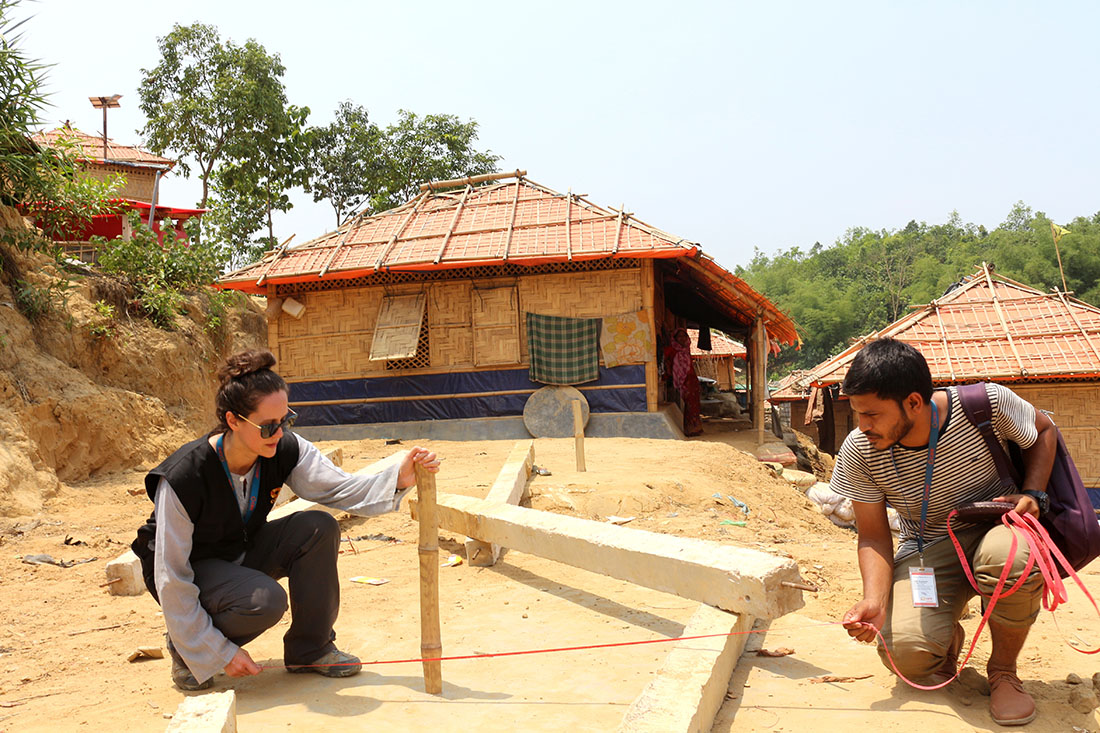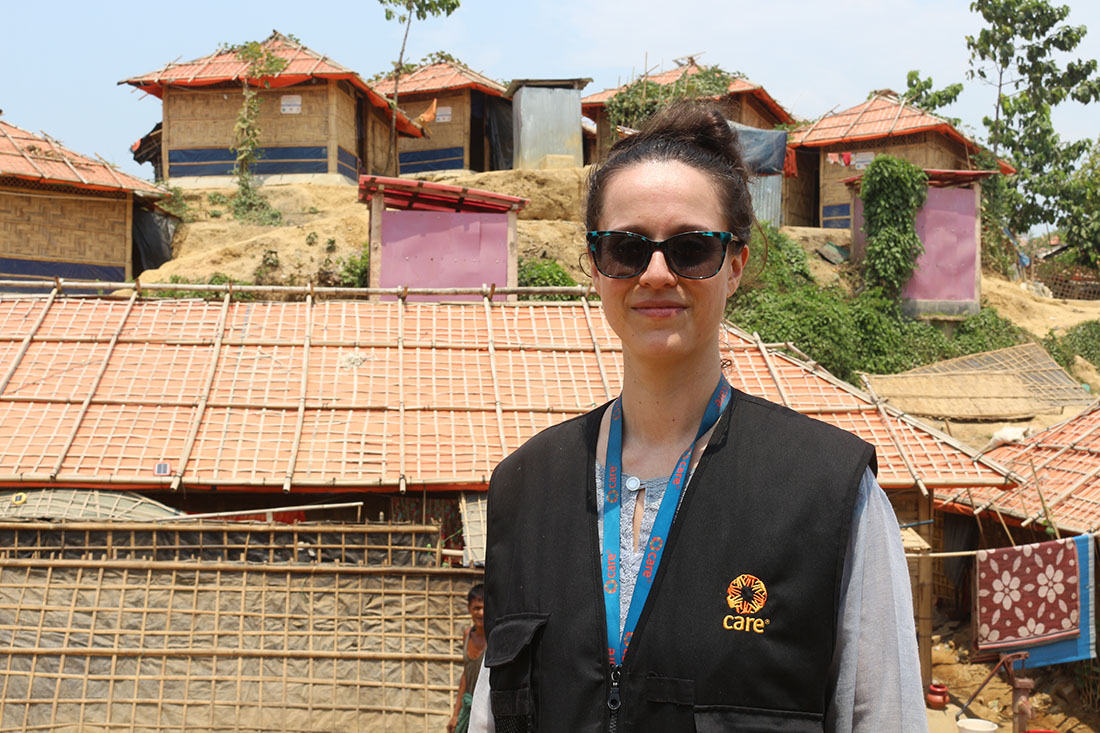
“Here, we have six seasons,” explained the Shelter Program Manager, Shah Suja, as we raced along the road that connects Cox’s Bazar town to the south-eastern tip of Bangladesh and the border with Myanmar, in places a mere two kilometers away. With the sun rising over what is proudly proclaimed to be “the longest beach in the world”, we were passing fields covered by leafy structures protecting betel nut from the sun and crescent-moon shaped boats, laden with fish, coming back into the estuary after several days at sea. Here, villagers would be siphoning seawater into shallow evaporation ponds, producers of coarse salt for sale. Winding through narrow country tracks to reach the camps, I noticed that the local children’s cricket ground of stubbly rice stalks had given way to the vibrant green shoots of the paddy fields, the second planting of rice that year.
With support from the players of the UK People’s Postcode Lottery, I was deployed from CARE’s global emergency shelter team to Cox’s Bazar with CARE Bangladesh in early November 2018, and was quickly embedded within the day-to-day management of programs providing emergency shelter, household items, site management, and basic infrastructure to the refugee camps. My questions in those early days revolved around understanding how people living in this corner of Bangladesh existed within this serene, rural environment, but where nature both nourishes and destroys. Each year, the searing heat of summer from March to May gives way to sudden and thunderous “Nor-wester” storms; every monsoon rain that refills the waterways and reinvigorates the land also cuts off villages, fills drains with silt, crumbles embankments, and makes roads impassable. Monsoon in June and July is bookended by periods when depressions in the Bay of Bengal whorl into cyclones and storm surges that threaten devastation to inland and coastal communities alike.
As one of the most impoverished parts of Bangladesh, Cox’s Bazar and Teknaf districts already faced a range of challenges within an already-vulnerable country. Then, in the space of a few months in 2017, over 740,000 Rohingya fled horror just across the border in Myanmar, finding refuge in the rolling, sandy hills of these districts’ national forests. Including those who had fled in previous years, this now brings the total Myanmar refugee population in Bangladesh to over 900,000. With almost 70 years of experience in the country responding frequently to natural disasters and building a strong system of early warning and Disaster Risk Reduction (DRR) with marginalized and vulnerable communities, CARE Bangladesh was uniquely positioned to respond. CARE currently focuses on sectors of site management, shelter, Water, Sanitation & Hygiene (WASH), sexual and reproductive health services, Gender-based Violence (GBV) prevention and response, and nutrition in the refugee camps, as well as integrated, multi-sectoral interventions and DRR within the surrounding hosting and impacted communities, directly reaching a total of 149,766 people to-date.
 According to the Shelter-NFI (non-food item) Sector, 88% of households have not received any further shelter support since the initial materials received when they first arrived, and are therefore a high risk of their shelters being damaged or destroyed during the wind and rain storms of the coming season. In March 2019, an unseasonal storm destroyed 476 shelters during one evening in CARE’s managed camps. A few days later, a further 696 shelters were damaged or destroyed, prompting an emergency response from both shelter and site management teams within CARE. Even normal weather conditions have the potential to create localized emergencies that stretch the capacities of first responders.
According to the Shelter-NFI (non-food item) Sector, 88% of households have not received any further shelter support since the initial materials received when they first arrived, and are therefore a high risk of their shelters being damaged or destroyed during the wind and rain storms of the coming season. In March 2019, an unseasonal storm destroyed 476 shelters during one evening in CARE’s managed camps. A few days later, a further 696 shelters were damaged or destroyed, prompting an emergency response from both shelter and site management teams within CARE. Even normal weather conditions have the potential to create localized emergencies that stretch the capacities of first responders.
Despite the huge amount of progress that has been made since 2017, less than 10% what is actually needed has been possible for this huge population in need. Through prioritization and mapping exercises, CARE has been identifying the areas at highest risk (for example, of flooding, high wind exposure, landslide, bridge collapse, foundation weaknesses etc.) and tackling those works first. Similarly, the shelters have been prioritized by those at greatest risk or poorest quality, particularly with regard to foundations and footings. But the need remains huge – CARE Bangladesh currently estimates that 4,000 households (approximately 20,000 people) will be seriously affected by the monsoon winds and rain (peaking in June and July) in the two CARE-managed camps alone. They will require emergency shelter materials - tarpaulin, rope, bamboo - to be able to reconstruct their shelters rapidly if they are damaged or destroyed.
INTEGRATED AREA APPROACHES
Strategically, CARE Bangladesh has decided to concentrate its efforts in the southern part of the refugee settlement, particularly in the two camps under its site management remit, seeking to strengthen integration of activities and maximize impact. Furthermore, with funding from USAID-OFDA, CARE has also established a strong presence within rural host communities in the southern part of the refugee settlement, including those neighboring and directly impacted by the camps managed by CARE. At the heart of CARE’s approach is a commitment towards inclusion, gender equality and the effective integration of gender throughout humanitarian action. For example, Gender in Emergencies specialists link up with shelter and infrastructure engineers to organize group discussions, consultation and information-sharing sessions and participatory planning exercises to identify risks, priorities activities and design programs. In the past six months, the number of female staff in the shelter team has increased by 43% - a significant feat given that many conservative attitudes prevail in this area, in a substantially male-dominated field of work. CARE’s women and girls’ safe spaces (WGSS) play host to a range of activities – from information sharing to counselling –and are an essential hub in the community where women and girls make up the vast majority of the refugee population.
CARE’s range of shelter, site development and infrastructure and site management work over the past year is funded by the International Organization for Migration (IOM), USAID-OFDA, Islamic Relief Worldwide (IRW), LDS Charities, Danish Emergency Relief Fund (DERF), Danish Relief Alliance (DRA), as well as with contingency funding from Aktion Deutschland Hilft (ADH) and the Luxembourg Ministry of Foreign Affairs. CARE International UK’s support to CARE Bangladesh’s humanitarian response program was made possible with the support of the players of the UK People’s Postcode Lottery.